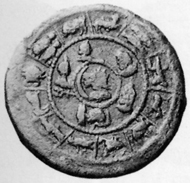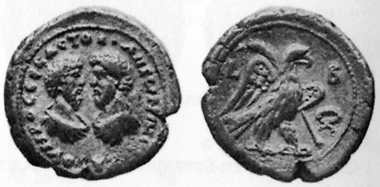Egypt and Alexandria. A brief numismatic survey: part III
The Great Year
Egypt had three different calendars. The first, civil one was linked to the flooding of the Nile. It was divided into Nile flood, fertile period and time of drought. These three seasons were subdivided into four months with 30 days each; the five days prior to the onset of the New Year were added to that, and that made 365 days in total.
The Egyptian astronomers, however, had realized from time immemorial that the civic calendar was out of step with the astronomical one. For the latter, they took the rise of Sirius, Egyptian Sotis, as fixpoint. It took 364 1/4 days, which meant that after four years the civic calendar differed from the astronomical year for one entire day. It took 1461 years for both calendars to become synchronized again.
Antoninus Pius, 138-161. Tetradrachm, 144/5. Rev. bust of Sarapis l., surrounded by the busts of the seven planetary gods, outside the twelve signs of the zodiac. CNG 13 (1990), 158.
It was on 19th July 139 that the rise of Sotis coincided with the onset of the civil year. Antonius Pius had ascended to the throne roughly one year before. Thanks to this astronomical event, he sniffed a chance to propagate his reign as an era of peace and a new start because the Roman calendar, too, was based on the circular movement. A society came into being, grew older and older until it rejuvenated by entering a new cycle and, being cleansed of all faults, started all over again.
That was the underlying idea of the Roman saeculum as well. Admittedly, there was no way for Antininus Pius to celebrate saecular games again for the last ones had just been commissioned by Domitian. The Great Year, however, perfectly atoned for that.
Antoninus Pius, 138-161. Tetradrachm, 138/9. Rev. Phoinix with nimbus. Auctiones 26 (1996), 411.
It is hardly surprising, therefore, that the concept of eternity was a subject matter for the Alexandrinian coins. The intriguing specimens from the mint in Alexandria with their astrological-astronomical backdrop very likely are only loosely connected with this celestial event. They merely evidence that the interest of the people of Egypt in the events at the starry firmament had risen considerably thanks to the ‘Great Year’, i.e. the coincidence of the beginning of both the civil and the astronomical year.
Modern scholars assume today that the gorgeous subjects designed in the mint of Alexandria under Antoninus Pius were not created by local die cutters, but that the mint got help from the capital.
Antoninus Pius, 138-161. Tetradrachm, 144/5. Rev. Judgement of Paris. CNG 13 (1990), 220.
This is the only way in which they are able to explain the high artistic merit of such reverses like the ones showing the Judgement of Paris…
Antoninus Pius, 138-161. Tetradrachm, 141/2. Rv. reaper. CNG 13 (1990), 221.
… the reaper …
Antoninus Pius, 138-161. Tetradrachmon, 142/3. Rev. Heracles beating his teacher, the centaur Pholos, to death with his lyre. CNG 13 (1990), 215.
… or the labors of Hercales.
A different but likely reason may well be – wealth. The one who possesses money in abundance might well come up with the idea of sending for the best die cutters of the empire. The governor of Alexandria had enormous means in the middle of the 2nd century since his province was doing better than ever.
Probably around the middle of the 2nd cent. A. D., a new sea route came into use thanks to a channel between the Nile River and the Red Sea. It led from the ports of India via Clyma, present-day Suez, to the Roman channel and from then on to the Nile from which the ships reached Alexandria and the Mediterranean Sea. Alexandria became the large transshipment point for goods from the Far East into the Roman Empire. The merchants of Alexandria very likely made good money. Roman customs collected 25 % tax on all goods imported across the boundary of the Roman Empire at Clyma. Pliny the Younger, writing already prior to the building of the channel, gives us an idea about the sums involved when he tells that allegedly goods worth 100 million sestertii had been imported from India every year. And that number is likely to have multiplied once the new trading route had become accessible.
Slump in Alexandria’s coinage under Marcus Aurelius
Whereas, at the beginning of the reign of Marcus Aurelius, large and rich emissions of Alexandrinian coins had been issued, the output of the mint of Alexandria began to decrease around 169/70. In the following year, 171, as few as four coin types were issued – for comparison: it had been 34 in 143/4 and even 70 in the year before that.
Marcus Aurelius, 161-180. Tetradrachm, 161/2. The busts of Marcus Aurelius and Lucius Verus opposing. Rev. eagle with palm branch, walking r. Auctiones 7 (1977), 454.
We do not know the exact reason for this slump in coins – but it was surely linked to an economic recession. Or was it due to the plague that probably afflicted Alexandria, the important trading city, quite heavily? Another possible cause might be raids from the desert tribes on the trading route to India of which we today lack any testimony.
Anyway, there must have been a severe turning point in the life of the province of Alexandria around 169/70 which is further hinted at by the revolt of the so-called Bucoli, a section of the population living their lives as herdsmen in the Nile delta. In 172, they defeated what was left of the legion stationed in Egypt – the major part of the Egyptian protection force was fighting the Marcomanni in the west – in a pitched battle. Avidius Cassius, appointed supreme commander of the east by Marcus Aurelius, had to come to Egypt with an army to restore order again. That took a special permission since the old regulation of Augustus – stating that no senator was allowed to enter the province of Egypt without the permission of the emperor – was still valid. The following events proved Augustus to be prudent.
After all, Egypt was no foreign place to Avidius Cassius. Before the emperor had appointed him senator, Cassius had been praefectus Aegypti. It is said that in 175 a rumor was spreading that Marcus Aurelius had died. Avidius Cassius was proclaimed emperor. The province of Egypt immediately stated it readiness to support him. So far, no Alexandrinian coins bearing his image are known to us. But, who knows? There is some possibility that they might show up at some point. Perhaps he was assassinated by its supporters when they learned that Marcus Aurelius was still alive, simply before any coins could have been produced. At any rate, the east was spared a bloody civil war. And Marcus Aurelius traveled to Egypt in the winter of 175/6 to have a look for himself which made the coin output of the Alexandrinian mint increase again. While we only know one single coin type from the years 13 (172/3) and 14 (173/4), there were already 11 types – with mainly military subjects on the reverses – produced in 175, and 16 types in the year after that.
Fear and rejoicing: Septimius Severus in Alexandria
Anyhow, at the end of the 2nd cent. A. D., Alexandria was a mere shadow of its former self. Economy was at rock bottom, and less and less coins were produced. In this devastating situation Septimius Severus visited the battered city in the winter of 199.
Julia Domna, + 217. Tetradrachm, 195/6. Rev. Dikaiosyne standing l. Heidelberger Münzhandlung 20/I (1997), 420. The coins of Septimius Severus and his family range amongst the great rarities of Alexandrinian coinage.
He had just concluded the civil war against Pescennius Niger in which the province of Egypt had taken sides with his enemy. Septimius Severus, however, did not punish Alexandria – on the contrary, after more than 200 years, the citizens were allowed elect a city council, a privilege the Alexandrinians had fought for since the reign of Augustus.
The family of Septimius Severus. Contemporary tondo, c. 199-201. The depiction of Geta was erased because of his damnatio memoriae. Berlin, Antikensammlung, inv. nr. 31329. Photograph: Ursula Kampmann.
In April 200, Septimius Severus embarked on a touristic trip. He visited Memphis and the pyramids, went up the Nile and via the Colossi of Memnon to the Sudanese border. Then Septimius Severus returned again, went to Alexandria, to Syria and from there to Rome where he arrived in A. D. 202.
The next episode focuses upon Caracalla, the son of Septimius Severus, and his visit to Alexandria which ended with bloodshed, and the turbulent 3rd century.
You can find the other parts of this series here.
Together with Thomas Ganschow, Ursula Kampmann has written a catalog on the Alexandrinian coins. For ordering it, please click here.
















